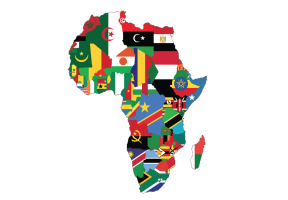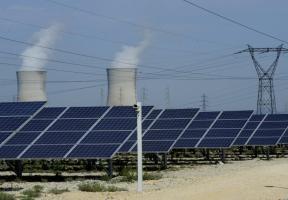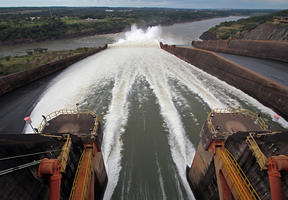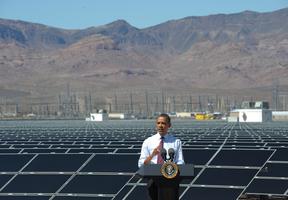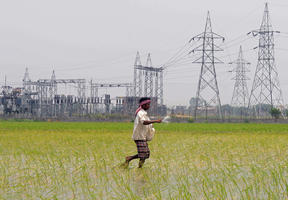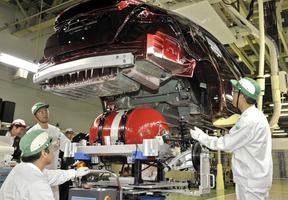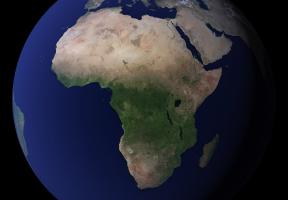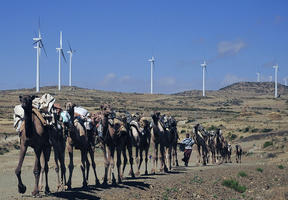
1. When will we change?
An Indian boy holds a sign “THE CLIMATE IS CHANGING, WHEN WILL WE?” at a climate march in New Delhi on the eve of the COP21 climate summit in December 2015. In a few years, India will overtake China as the world’s most populous country. Although it still relies heavily on , the country has launched an ambitious program.

2. A strong dependence on coal
In 2015, India became the second-largest coal consumer, behind China but ahead of the United States. Due to the widespread inefficiency of its coal mining operations, India must import a third of its coal needs, costing it $16 billion a year. Pictured here, piles of coal lying on the wharf at Mundra Port, 400 kilometers from Ahmedabad in western India.

3. 80% of the country’s electricity produced from coal
India has a large number of coal-fired plants. The Wanakbori power station shown here is located in a rural village 120 kilometers from Ahmedabad. Despite the cancellation of four large plants in June 2016, Indian demand for coal is expected to rise by 5% a year until 2021.

4. The Meghalaya mines
Coal mining practices in Meghalaya are still primitive. Inhabited by indigenous tribes, this small state in northeastern India, between Bangladesh and Myanmar, is home to thousands of private mines. They employ young boys who are slim enough to squeeze into the deep, narrow tunnels and extract the coal with rudimentary tools. In this photograph taken in the village of Rimbay, a miner climbs up a bamboo ladder carrying a load of coal on his back.

5. Urban pollution
Due to the massive use of coal to generate , the growing number of vehicles on the road, inefficient waste management and low environmental standards, pollution has become a major concern in India’s largest cities, especially in the capital New Delhi. Here in the northern Indian city of Allahabad, the driver of an old pedal rickshaw talks on his cell phone as fumes from an plant sweep through the street.
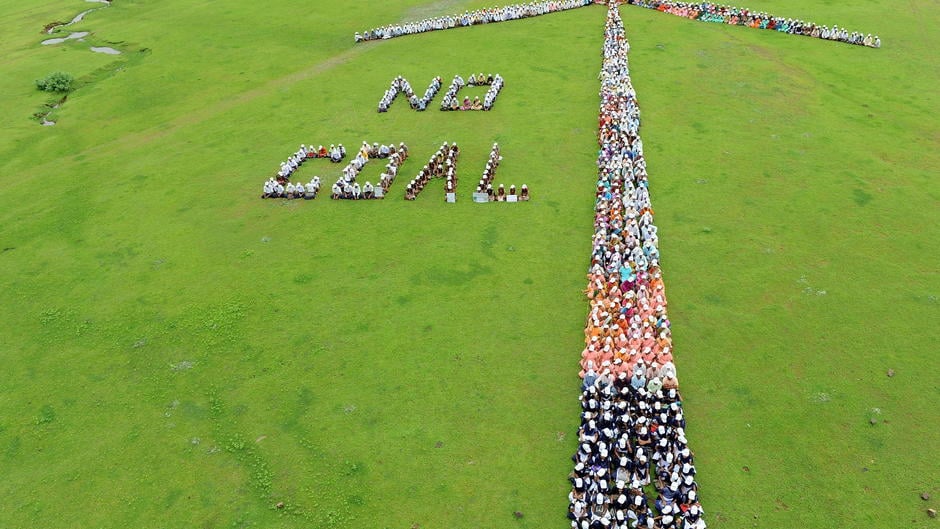
6. No coal
Deep concern for a more sustainable economy is prompting action. In this photo, inhabitants from nine villages in the vicinity of Alibag, in the state of Maharashtra, are seated in a formation depicting a wind turbine and the words “NO COAL”. They are protesting against the construction of four coal-fired power plants that they fear will destroy fertile farmland.

7. Access to energy still shaky
In India, one of the major impediments to development both in the countryside and the poor city suburbs is the lack of access to energy for lighting, heating and cooking. Kerosene, wood and dried cow dung cakes (pictured in the middle of the photo) continue to be the main sources of energy in the most destitute areas. A more efficient way for the population to meet its needs would be to use solar lamps, solar cookers, bottled natural gas and from waste.

8. Another fast-growing sector
To make up for the lack of energy availability, India has embarked on an ambitious program to expand renewables. It includes the construction of large solar farms with a target capacity of 60 gigawatts by 2022. Pictured here is the Roha Dyechem solar plant in northern Rajasthan. In the fall of 2016, the Kamuthi Solar Power Project was inaugurated in Tamil Nadu in southeast India. With a capacity of 648 megawatts, it will eventually be the world’s largest solar plant.
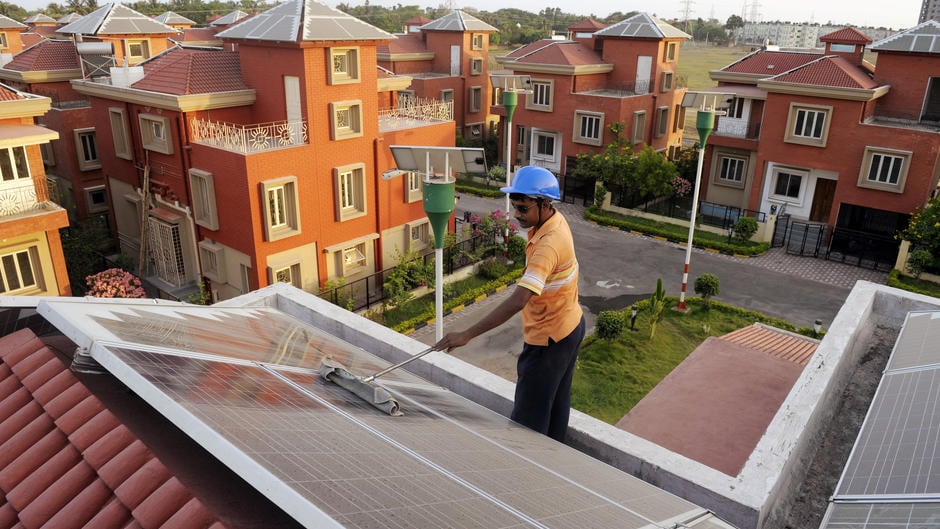
9. Rooftop solar
India’s plan to increase its solar power generation capacity includes 40 gigawatts of rooftop solar installations, which would account for 40% of the country’s total solar energy target. Under plans for new urban development projects, buildings will be fitted with solar panels to help them partially meet their energy needs, like here in New Town, in the state of Bengal, not far from Kolkata (formerly Calcutta).
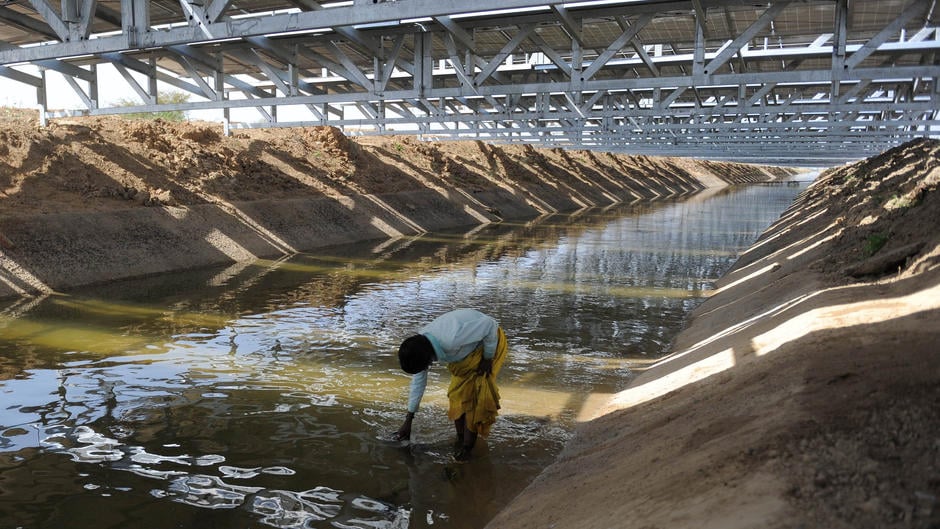
10. A solar system that prevents evaporation
In Chandrasan, in the western state of Gujarat, a 750-meter section of an irrigation canal has been covered by a canopy of photovoltaic panels. The structure has a two-fold advantage. It has the capacity to produce one megawatt of electricity, and it reduces evaporation loss in a region with a hot climate. The result is a savings of nine million liters of water per year.

11. Solar-powered pumps
Irrigation is crucial for agriculture in a country that has many arid regions. Solar-powered pumps are gradually replacing oil pumps. In the village of Dhundi, near Ahmedabad in northwest India, the solar panel installation pictured here was 95% financed by grants. The remaining 5% was financed by the farmers themselves, who are offsetting the cost by selling excess electricity to the public grid.

12. A surge in wind power
Power output from wind turbines expanded ten-fold between 2002 and 2012, and India now ranks fourth worldwide in wind power behind China, the United States and Germany. The southern Tamil Nadu region and the Mumbai (formerly Bombay) area are home to the country’s largest wind farms. Pictured here, workers at the Vankusawade wind farm, 350 kilometers from Mumbai.

13. A robust wind industry
India has established a solid wind industry, thanks in particular to the turbine manufacturer Suzlon. The company, which is present across the entire turbine manufacturing chain, has also successfully expanded internationally. The blade plant in this photo is located in Paddhar, 400 kilometers from Ahmedabad, in western India.

14. A booming nuclear industry
India, which has been a nuclear power for decades, already operates 20 civilian nuclear reactors. Seven other reactors are under construction and 18 new projects have been announced. India is also actively engaged in research on fourth-generation reactors, also called fast reactors. Pictured here, the Tarapur atomic power plant in the state of Maharashtra, whose capital is Mumbai. This photo shows the prototype fast breeder reactor at the Kalpakkam nuclear complex in the southern Indian state of Tamil Nadu.

15. A high-tech country
India is a technologically advanced country despite the fact that many of its regions are underdeveloped. In addition to hosting countless companies in the digital sector, India is a leading global software vendor and provider of data processing services. In this photo, an engineer uses augmented reality to examine a car engine at Bengaluru ITE.biz, one of the world’s biggest IT and electronics events held in Bangalore.

16. A large middle-class market
India’s population is projected to reach 1.5 billion around the year 2030, placing it ahead of China. The middle class, which is enjoying greater purchasing power, is expanding at a brisk pace. The steady development of the two-wheel vehicle and automobile market – and consumption in general – has led to a concomitant increase in energy demand. In this typical Indian street scene, an entire family whizzes by on a brand new scooter.
 Geopolitics of energy
Geopolitics of energy
See all
